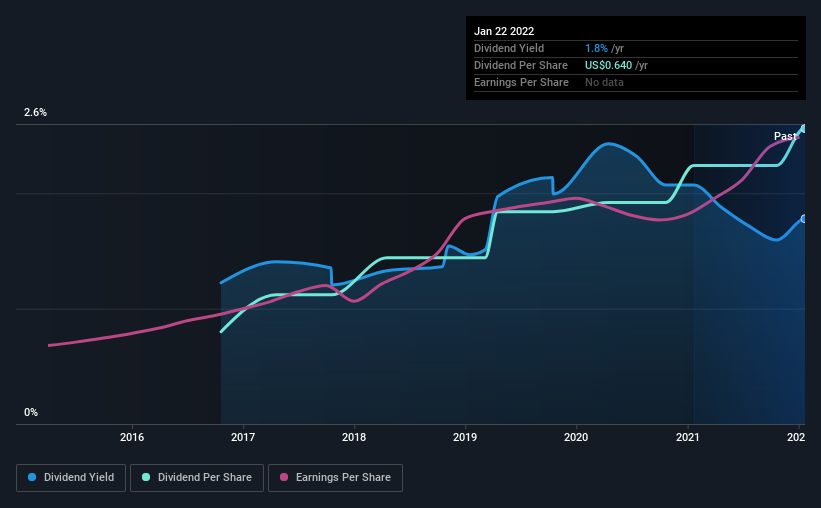Plumas Bancorp (NASDAQ:PLBC) Looks Like A Good Stock, And It's Going Ex-Dividend Soon
Plumas Bancorp (NASDAQ:PLBC) stock is about to trade ex-dividend in four days. Typically, the ex-dividend date is one business day before the record date which is the date on which a company determines the shareholders eligible to receive a dividend. The ex-dividend date is of consequence because whenever a stock is bought or sold, the trade takes at least two business day to settle. This means that investors who purchase Plumas Bancorp's shares on or after the 28th of January will not receive the dividend, which will be paid on the 15th of February.
The company's next dividend payment will be US$0.16 per share, and in the last 12 months, the company paid a total of US$0.64 per share. Based on the last year's worth of payments, Plumas Bancorp has a trailing yield of 1.8% on the current stock price of $35.97. We love seeing companies pay a dividend, but it's also important to be sure that laying the golden eggs isn't going to kill our golden goose! As a result, readers should always check whether Plumas Bancorp has been able to grow its dividends, or if the dividend might be cut.
Check out our latest analysis for Plumas Bancorp
Dividends are typically paid from company earnings. If a company pays more in dividends than it earned in profit, then the dividend could be unsustainable. Plumas Bancorp paid out just 14% of its profit last year, which we think is conservatively low and leaves plenty of margin for unexpected circumstances.
Generally speaking, the lower a company's payout ratios, the more resilient its dividend usually is.
Click here to see how much of its profit Plumas Bancorp paid out over the last 12 months.
Have Earnings And Dividends Been Growing?
Businesses with strong growth prospects usually make the best dividend payers, because it's easier to grow dividends when earnings per share are improving. If earnings fall far enough, the company could be forced to cut its dividend. Fortunately for readers, Plumas Bancorp's earnings per share have been growing at 19% a year for the past five years.
Many investors will assess a company's dividend performance by evaluating how much the dividend payments have changed over time. Plumas Bancorp has delivered 26% dividend growth per year on average over the past five years. Both per-share earnings and dividends have both been growing rapidly in recent times, which is great to see.
To Sum It Up
Has Plumas Bancorp got what it takes to maintain its dividend payments? Companies like Plumas Bancorp that are growing rapidly and paying out a low fraction of earnings, are usually reinvesting heavily in their business. This is one of the most attractive investment combinations under this analysis, as it can create substantial value for investors over the long run. Overall, Plumas Bancorp looks like a promising dividend stock in this analysis, and we think it would be worth investigating further.
In light of that, while Plumas Bancorp has an appealing dividend, it's worth knowing the risks involved with this stock. Our analysis shows 3 warning signs for Plumas Bancorp and you should be aware of these before buying any shares.
We wouldn't recommend just buying the first dividend stock you see, though. Here's a list of interesting dividend stocks with a greater than 2% yield and an upcoming dividend.
Have feedback on this article? Concerned about the content? Get in touch with us directly. Alternatively, email editorial-team (at) simplywallst.com.
This article by Simply Wall St is general in nature. We provide commentary based on historical data and analyst forecasts only using an unbiased methodology and our articles are not intended to be financial advice. It does not constitute a recommendation to buy or sell any stock, and does not take account of your objectives, or your financial situation. We aim to bring you long-term focused analysis driven by fundamental data. Note that our analysis may not factor in the latest price-sensitive company announcements or qualitative material. Simply Wall St has no position in any stocks mentioned.

 Yahoo Finance
Yahoo Finance 